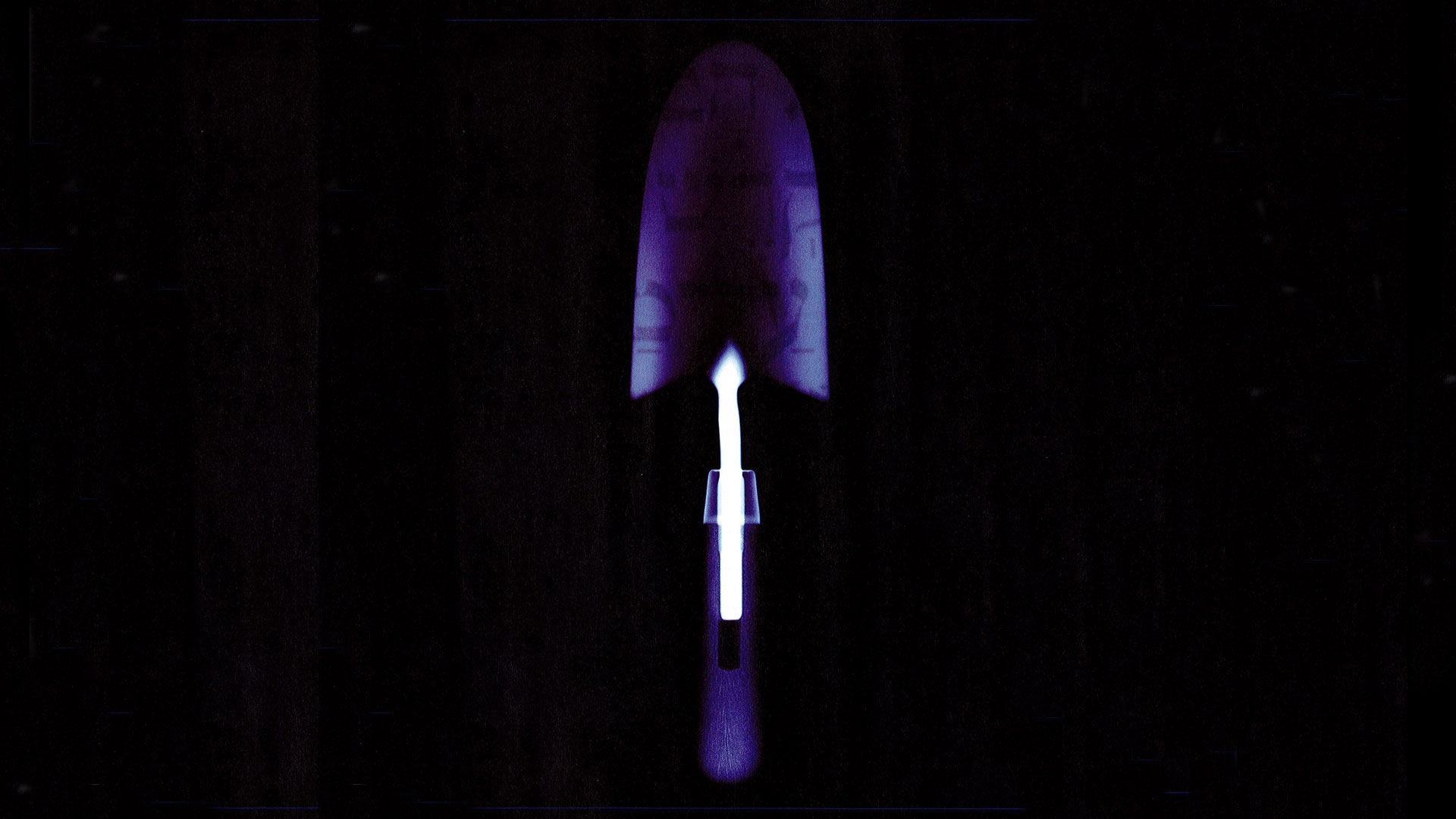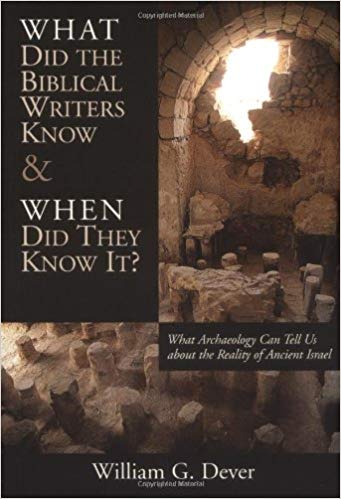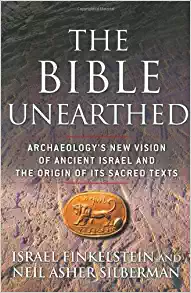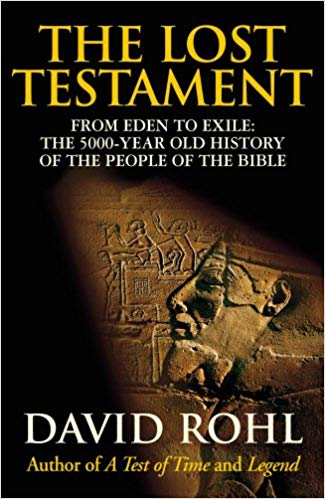Holes in History
Archaeology and the Bible
A new war is on in the Middle East, but the battleground this time is in the fields of archaeology and history. And at the center of the fray is the Bible’s credibility as an accurate history of the region.
What Did the Biblical Writers Know and When Did They Know It?
William G. Dever. William B. Eerdmans, Grand Rapids, Michigan. 313 pages.
The Bible Unearthed: Archaeology’s New Vision of Ancient Israel and the Origin of Its Sacred Texts
Israel Finkelstein and Neil Asher Silberman. 2001. The Free Press, New York. 385 pages.
The Lost Testament: From Eden to Exile: The Five-Thousand-Year History of the People of the Bible
David Rohl. 2002. Random House, London. 513 pages.
In reviewing three books on this subject, it is important to note that none of the authors considers himself to be deeply religious with a belief that has to be protected. William Dever nonetheless approaches archaeology with a missionary zeal. He has given deep thought to the philosophical underpinnings of the subject. Israel Finkelstein is a leading Israeli archaeologist whom Dever would classify as a revisionist or minimalist because he contends that the Bible is a late invention of Hellenistic Jews. David Rohl, on the other hand, is clearly a maximalist—one who believes that archaeology can largely support the historical record of the Bible.
Archaeology and the Bible
In many Western nations the Bible has provided the foundation for society and civility. But its historical accuracy and its value as a source of truth are increasingly coming under fire. Fanning most of the critical flames are minimalists and revisionists.
Enter William G. Dever, author of What Did the Biblical Writers Know and When Did They Know It? Dever acknowledges having been grounded in the Bible as a child: his father was a fundamentalist preacher. Though the younger Dever does not share that fundamentalism, he does admit that some of his father’s approach rubbed off on him: “I can still hear the cadence of his booming voice as he read Scripture from the pulpit; and I suspect that some of my own homiletical style in the classroom and in popular lectures comes from him.”
As a young adult, Dever resisted delving into a critical study of the Bible, primarily because he felt his faith was on the line. Eventually, though, his love of learning prompted him to enroll at Harvard to pursue a doctorate in biblical theology. Upon graduating he spent 11 years in Israel directing various research institutions. He became absorbed in the archaeology of the biblical world and rose to head the Albright School, a respected archaeological institution. He explains, “I began to see how the realia of archaeology could illuminate ancient Israel. And I caught a vision of a dialogue between archaeology and biblical studies.”
Why did he write this book? “Because I had to,” he says, “not only to counter the ‘revisionists’ abuse of archaeology, but to show how modern archaeology brilliantly illuminates a real ‘Israel’ in the Iron Age [which began in the Middle East about 1200 BCE], and also to help foster the dialogue between archaeology and biblical studies that I had always envisioned.”
The first half of the book is devoted to a history of archaeology, the changes it has undergone, as well as the challenges it faces today. Dever compares the challenges of biblical archaeology in Syro-Palestine, or the Southern Levant, to those of Old Testament biblical studies. Both disciplines have lost credibility in nonfundamentalist academia. They have been replaced by literary studies of the Old Testament and by minimalist histories that do a disservice to archaeology and the Bible record alike.
Dever believes that both archaeology and the Bible record have a contribution to make. But, he contends, the archaeological record and the text of the Old Testament need to be subjected to the same interpretive standards so that they can speak to one another. To that end, he sets out to disprove the revisionist view of the history of Israel by using text and artifact together on an equal footing.
Revisionists Exposed
Dever makes a good argument for the existence of a real Israel during the Iron Age, starting with the Book of Judges and leading into the period referred to as the United Kingdom of David and Solomon. His reconstruction of this key period seems to expose the revisionists’ abuse of archaeological data and reveals the weaknesses of their revised histories.
Dever makes a good argument for the existence of a real Israel during the Iron Age.
The area of controversy that he tackles is the use of a written language by Israel’s populace prior to the seventh century BCE, which the revisionists claim is the earliest date from which the Bible could have been written. This is the central tenet of Israel Finkelstein’s book, The Bible Unearthed. Dever states that “a number of individual ostraca [pottery fragments which have been used as memos] are . . . now known, enough to show beyond doubt that extensive written materials did exist in ancient Israel besides official archives, that is, that many besides elites could read and write.”
One ostracon found in the 1980s in the eastern Negev Desert is of particular importance. It dates back to the seventh century BCE and is written in Hebrew, but it also contains a list of Egyptian hieratic signs for numbers. For some reason the Egyptian system of numerals was preferred and used throughout Israel and Judah. Dever notes that Jewish history professor Nadav Na’aman “has recently suggested that this system must have been adopted from Egypt by the 10th century; it cannot have been borrowed from Israel’s Semitic neighbors, since none used it. And it is conspicuously unattested in Egypt itself in the eighth–seventh centuries, so it must derive from an earlier time.” Na’aman, who is not a biblicist, concludes that this evidence “requires the historian to take seriously the biblical concept of a Davidic-Solomonic ‘kingdom.’” Dever, contrary to the revisionists, believes that clear archaeological evidence of a writing tradition exists from the time of David onward, even though hard evidence has not yet been recovered.
What is more, the history recorded in the Bible includes details of other nations and events that would not have been known had the history been written in the seventh century or in the postexilic period (after 538 BCE). The basic history must have been recorded by a contemporary of the event. The early prophets also provided an insight into the life of the nation of Israel, and it agrees with the archaeological record.
Dever’s conclusions are hard to ignore. He believes that while the Hebrew Bible is not “history” in the modern sense, it nevertheless contains the outline, as well as many details, of a real “ancient Israel” in the Iron Age. He goes on to say that we should separate theology, religion and morality, and realize that they are not one and the same.
The biblical writers are making statements based on faith, he says. We must remember that the Bible’s main thrust isn’t as much about the story or about historicity as it is about the major player: God. “The real question,” Dever states, “is whether the faith of the writers of the Hebrew Bible can any longer be ours. For some it can be; for others not.”
Dever notes that for fundamentalists, either Christian or Jewish, it is a trying thing to dig up what could be evidence against their faith. If the Bible is not proved 100 percent accurate, such people can find themselves questioning how “such a fraudulent literature [can] be the basis for any system of belief, morality, or cultural value.”
He states that even if people believe that some of the biblical writers exaggerated facts and got the chronology wrong, they should not be quick to judge the overall message of the Bible. He concludes that we can get bogged down in language, context and literal meaning and lose sight of the larger truth that the biblical writers ultimately wanted to convey.
Dever’s book is more than a rebuttal of the minimalist and revisionist schools. It is a seminal work on the nature and challenges of archaeology as it has developed over the past two centuries, and on where it needs to go to remain relevant in the 21st. He is driven by a vision for the future of a discipline that he clearly loves and with which he identifies.
Rewriting History
The Bible Unearthed is a controversial work that has brought much attention to its authors. A Hebrew-language edition has recently been published, which includes an enlarged introduction in which the authors seek to allay concerns that archaeologists’ claims might impact the faith of readers.
Israel Finkelstein directs the Sonia and Marco Nadler Institute of Archaeology at Tel Aviv University. He was joined in writing this volume by Neil Asher Silberman, director of historical interpretation for the Ename Center for Public Archaeology and Heritage Presentation in Belgium, and a contributing editor to Archaeology magazine. Finkelstein is currently a director of Tel Aviv University’s excavation at Tel Megiddo, which, because scholars have dug there for so long, provides him an opportunity to review and critique the work of some of the field’s 20th-century giants.
Finkelstein offers a rewrite of biblical history based on his perspective on a century of excavation. He believes the day has come when archaeology can stand on its own feet as a science rather than an art, and that it can single-handedly provide the truth regarding development of the nation and religion of Israel.
Most importantly, Finkelstein asserts, it is time for archaeology to cut loose its attachment to the Bible to establish time frames.
Most importantly, he asserts, it is time for archaeology to cut loose its attachment to the Bible to establish time frames. As an example, he cites the linkage of Megiddo’s gates to King Solomon based on 1 Kings 9:15. In his opinion, the gates belong to the eighth century, some 200 years later. The use of Scripture to date the gates is simply a case of circular reasoning, he says.
Most of the book deals with Finkelstein’s reconstruction of the history of Israel and Judah and his assertion that the Bible was written in the seventh century BCE. He maintains that the story of the united monarchy, with Jerusalem as its bejeweled capital dominated by a holy temple of monumental size and importance, is a myth. It was created as part of the religious reforms of King Josiah just prior to the Babylonian captivity in an effort to elevate Jerusalem and corroborate the existence of the kingdom of Judah in the seventh century. The real wealth and political fortune, he claims, were in the northern kingdom of Israel. Judah was always the poor cousin in the south. Finkelstein questions whether anything existed in Jerusalem in the 10th century BCE—the time of the reigns of David and Solomon.
The Written Record
Does Finkelstein’s hypothesis hold? Let’s examine his claims regarding the lack of evidence of writing in Jerusalem prior to the late eighth century.
Finkelstein claims that “the royal citadel of Jerusalem was transformed in a single generation from the seat of a rather insignificant local dynasty into the political and religious nerve center of a regional power.” As a result, “it became a full-fledged state” for the first time, and a national religion was established under King Hezekiah in the late eighth century BCE. Continuing reformation took place under Josiah a century later, and the Scriptures began to be written.
But if the Bible was written in the seventh century, why would it have included material from what some scholars contend are two often-contradictory sources to outline the history of Judah? Yet this is what Finkelstein proposes. And why would it also have included the traditions of the northern tribes of Israel, which had separated themselves from Judah in the 10th century BCE to become an independent nation?
Could a community such as Jerusalem, which Finkelstein claims had been without any history or written record, have produced a document the size of the Scriptures? Without a continuous writing tradition that maintained and preserved the history and other material in some form, it seems an unrealistic claim. And while societies may maintain their own traditions in verbal form, how do they maintain what Finkelstein sees as competing traditions, not to mention the history and traditions of another nation or group with which they were no longer affiliated?
Such difficulties highlight a fundamental flaw in Finkelstein’s logic. If the Bible can’t provide a time frame for Middle Eastern archaeology, then something else has to be used to establish the baselines. Archaeology cannot provide that for itself. (Hence Dever’s appeal to use both the biblical text and the archaeological record, but subjected to identical levels of and approach to interpretation.)
Finkelstein has proved (though perhaps not yet to himself) that archaeology can’t provide a complete record of history of and by itself.
Finkelstein’s desire to avoid circular reasoning in his discipline may be commendable, but to replace it with personal interpretation that can’t be tested begs a question. In writing this book, Finkelstein has proved (though perhaps not yet to himself) that archaeology can’t provide a complete record of history of and by itself.
A Matter of Time
David Rohl enters the fray on another front, but one that is germane to all of archaeology. He focuses on an earlier period than do Dever and Finkelstein.
What makes The Lost Testament different from other books aimed at explaining the archaeology and history of the Middle East? Chronology does, according to the author. Rohl’s premise is that the timeline of events that was established in the past is off by about 350 years. He terms his new standard of dating “new chronology.”
Rohl states that many of the scholars digging in the ruins of the Middle East are simply digging in the wrong place or at the wrong level. That, he says, is why archaeology doesn’t support many of the biblical accounts. It has been based on what he calls “old chronology.”
He writes, “If you look for the fallen walls of Jericho in the levels of the Late Bronze Age at Tell es-Sultan (the modern Arabic name of the ruin mound of Jericho) you will not find them. But if you dig several metres deeper, the fallen walls of Joshua’s Jericho are there to be unearthed. Indeed, they have already been partially excavated but simply remain unrecognised for what they are.” He believes the archaeology of his colleagues does not support the biblical stories of the Exodus, King David, King Solomon and others, though he doesn’t suggest that his colleagues are anti-Bible.
Rohl accuses young scholars who have seen the evidence of the new chronology and know that it fits into their research of being afraid to buck the status quo. He believes they are afraid of condemnation from their peers.
Rohl maintains that the disinformation surrounding his new chronology has been led by Kenneth Kitchen, a leading Egyptologist formerly with Liverpool University. Some of Kitchen’s Israeli contemporaries can see the contradictions, but Rohl states that they just “look puzzled, scratch their heads, go back to their digs and continue to use Kitchen’s dating.” And who can blame them? As Rohl acknowledges, they would be overturning 200 years of historical reconstruction.
The heart of the problem, according to Rohl, is the identification of the Pharaoh Sheshonq I with the biblical character Shishak. The basis of the identification is simply the similarity of the names, first noted by the French archaeologist Jean-François Champollion in the early 19th century. Rohl contends that they were two separate individuals with different goals in their wars with Judah and the northern kingdom of Israel. Champollion’s assumption nonetheless underlies all dating of Iron Age archaeology in Israel, as well as the dating of the Egyptian pharaohs.
But does Rohl provide proof of his new chronology and conclusively account for the 200- to 350-year gap in time? He keeps referring back to his previous writings to validate his theory of wrong timelines. So to get a handle on this issue, one apparently has to invest a bit more time in reading earlier books on the subject.
Certainly the new chronology timeline fits neatly into the literal Bible student’s vocabulary and mindset. It appears to validate many of the stories that contemporary archaeologists’ work denies. Yet even some of Rohl’s maximalist colleagues, such as Bryant G. Wood, who claims archaeological evidence for his own belief and agrees with Rohl about the remains of Jericho, reject Rohl’s chronology because of the chaos it creates in other parts of the biblical account. In fact, the whole spectrum of archaeologists, from maximalist to minimalist, would cry foul at the suggestion that Rohl’s findings be taken at face value.
Rohl admits that he has been labeled by the academic community of his field as a charlatan and a crank. But he says that this can be expected when overturning dating methods that have spanned so many years. What is his advice? “Please remember that this is all ‘work in progress’ and is not set in stone like the conventional chronology,” he says. “What makes the New Chronology so exciting is that it is not stuck in its own dogma. Flexibility and a willingness to adjust are a hallmark . . . not a weakness.”
In that light, the book covers a variety of biblical stories from a historical point of view. His hopes for those who read this book are that they “will enjoy delving a little more deeply into this fascinating field of research which has been described as ‘a Sherlock Holmes mystery with four-thousand-year-old clues.’” Clearly that is a worthwhile end.




